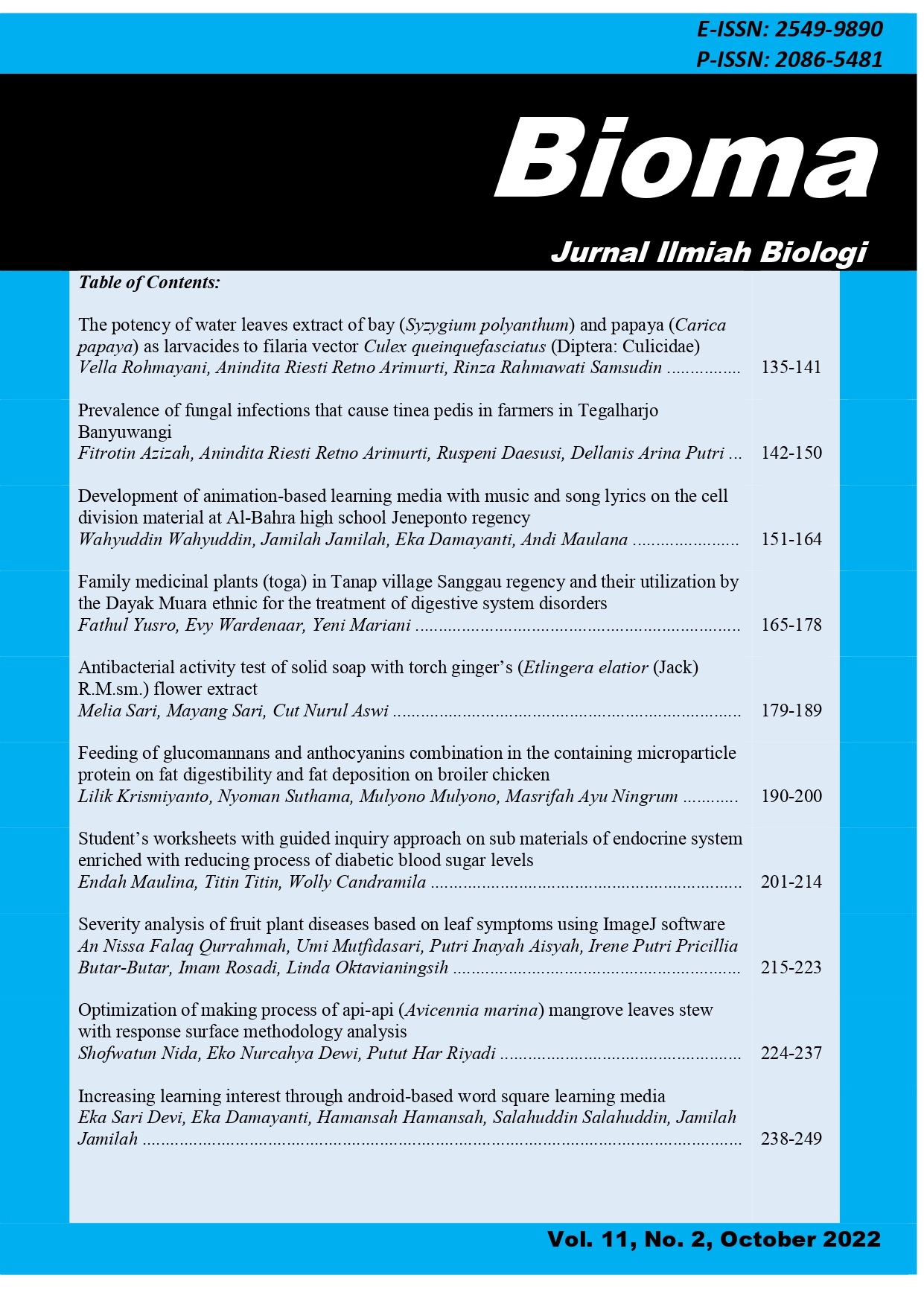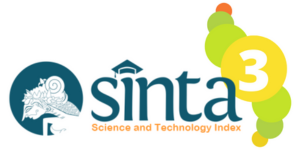ISOLATION OF AnsB GENE FRAGMENT ENCODING L-ASPARAGINASE 2 ENZYME FROM Serratia plymuthica UBCF_13 AND IT’S IN-SILICO DOMAIN CHARACTERISTIC
DOI:
https://doi.org/10.26877/n5mfhy69Keywords:
Acute Lymphoblastic Leukemia, AnsB gene, L-Asparaginase type2 enzyme, PCR-based cloning., Serratia plymuthica UBCF_13Abstract
Acute lymphoblastic leukemia(ALL) is one of the cancer diseases often occurs in children and causes high mortality in children. One of the chemotherapy treatment suggested is using L-Asparaginase 2. However due to its difficult production process making this approach expensive for the public. Therefore production technology of this enzyme is crucial enabling cheaper for ALL treatment. This study aimed to isolate the AnsB gene sequence from Serratia plymuthica UBCF_13 and perform its further in-silico analysis. The research was started by designing specific primers for the AnsB gene, isolating the AnsB gene fragment using PCR-based approach, sequencing the AnsB gene fragment, cloning the fragment to the plasmid vector and further transformed into E. coli DH5α cell. Further data analysis was carried out using some bioinformatics tools such as BLAST, MEGA X, I-TASSER InterPro. Sequence data result successfully verified that the full length of AnsB gene is 1047 bp. InterPro analysis indicated that the L-Asparaginase 2 from S. plymuthica UBCF_13 has 2 domains, namely L-Asparaginase N-terminal spanning from amino acid 26 to 216, while its C-terminal spanned from amino acid 235 to 345. The physical fragment of the gene was also successfully cloned to the pGEM-T Easy vector and subsequently transformed into E. coli DH5α cell. This result provided information for alternative sources of L-Asparaginase 2 and it’s possible engineering.
References
Aisyah, S. N., Sulastri, S., Retmi, R., Yani, R. H., Syafriani, E., Syukriani, L., Fatchiyah, F., Bakhtiar, A., & Jamsari, J. (2017). Suppression of Colletotrichum gloeosporioides by Indigenous Phyllobacterium and its Compatibility with Rhizobacteria. Asian Journal of Plant Pathology, 11(3), 139–147. https://doi.org/10.17311/ajppaj.2017.139.147
Azouri, D., Abadi, S., Mansour, Y., Mayrose, I., & Pupko, T. (2021). Harnessing machine learning to guide phylogenetic-tree search algorithms. Nature Communications, 12(1), 1983. https://doi.org/10.1038/s41467-021-22073-8
Borah P. (2011). Primer designing for PCR Science Vision 11 (3), 134-136. https://www.sciencevision.org/issue/33/article/22
Carter, M., Essner, R., Goldstein, N., & Iyer, M. (2022). Molecular Cloning and Recombinant DNA Technology. In Guide to Research Techniques in Neuroscience (pp. 227–243). Elsevier. https://doi.org/10.1016/B978-0-12-818646-6.00014-2
Darvishi, F., Jahanafrooz, Z., & Mokhtarzadeh, A. (2022). Microbial L-asparaginase as a promising enzyme for treatment of various cancers. Applied Microbiology and Biotechnology, 106(17), 5335–5347. https://doi.org/10.1007/s00253-022-12086-8
Du, M., Chen, W., Liu, K., Wang, L., Hu, Y., Mao, Y., Sun, X., Luo, Y., Shi, J., Shao, K., Huang, H., & Ye, D. (2022). The Global Burden of Leukemia and Its Attributable Factors in 204 Countries and Territories: Findings from the Global Burden of Disease 2019 Study and Projections to 2030. Journal of Oncology, 2022, e1612702. https://doi.org/10.1155/2022/1612702
Fatiah, R., Suliansyah, I., Tjong, D. H., Syukriani, L., Yunita, R., Trivano, R., Azizah, N., & Jamsari, J. (2021). Genome of Serratia plymuthica UBCF_13, Insight into diverse unique traits. F1000Research, 10, 826. https://doi.org/10.12688/f1000research.54402.1
Finn, R. D., Attwood, T. K., Babbitt, P. C., Bateman, A., Bork, P., Bridge, A. J., Chang, H.-Y., Dosztányi, Z., El-Gebali, S., Fraser, M., Gough, J., Haft, D., Holliday, G. L., Huang, H., Huang, X., Letunic, I., Lopez, R., Lu, S., Marchler-Bauer, A., & Mi, H. (2016). InterPro in 2017—beyond protein family and domain annotations. Nucleic Acids Research, 45(D1), D190–D199. https://doi.org/10.1093/nar/gkw1107
Hall, T.A. (1999). BioEdit: A User-Friendly Biological Sequence Alignment Editor and Analysis Program for Windows 95/98/NT. Nucleic Acids Symposium Series, 41, 95-98. https://www.scirp.org/reference/ReferencesPapers?ReferenceID=1383440
Langley, K. E.; Villarejo, M. R.; Fowler, A. V.; Zamenhof, P. J.; Zabin, I. (1975). "Molecular basis of beta-galactosidase alpha- complementation". Proceedings of the National Academy of Sciences of the United States of America. 72 (4): 1254–1257. DOI:10.1073/pnas.72.4.1254.
Maese, L., & Rau, RE. (2022). Current Use of Asparaginase in Acute Lymphoblastic Leukemia/Lymphoblastic Lymphoma. Frontiers in Pediatrics, 10. https://www.frontiersin.org/articles/10.3389/fped.2022.902117
Nag, R., Joshi, S., Rathore, A. S., & Majumder, S. (2023). Profiling Enzyme Activity of l-Asparaginase II by NMR-Based Methyl Fingerprinting at Natural Abundance. Journal of the American Chemical Society, 145(19), 10826–10838. https://doi.org/10.1021/jacs.3c02154
Paysan-Lafosse, T., Blum, M., Chuguransky, S., Grego, T., Pinto, B. L., Salazar, G., Bileschi, M., Bork, P., Bridge, A., Colwell, L., Gough, J., Haft, D., Letunić, I., Marchler-Bauer, A., Mi, H., Natale, D., Orengo, C., Pandurangan, A., Rivoire, C., & Sigrist, CJA. (2022). InterPro in 2022. Nucleic Acids Research, 51(D1), D418–D427. https://doi.org/10.1093/nar/gkac993
Purwakasih, DB., & Achyar, A. (2021). Desain Primer dan PCR In Silico untuk Deteksi Shigella Sp. pada Sampel Air Minum Isi Ulang. Serambi Biologi. 6(1): 1-6. DOI: http://dx.doi.org/10.24036/11072RF00
Roy, A., Kucukural, A., & Zhang, Y. (2010). I-TASSER: A unified platform for automated protein structure and function prediction. Nature Protocols, 5(4), 725–738. https://doi.org/10.1038/nprot.2010.5
Rhalem, W. Mhamdi JE., Raji M, Hammouch A., Kharmoum N., Raoui S, Saaid A., Hamdi S & Ghazal H. (2020). Novel Alignment Approach of DNA Sequences. In: El Moussati, A., Kpalma, K., Ghaouth Belkasmi, M., Saber, M., Guégan, S. (eds) Advances in Smart Technologies Applications and Case Studies. SmartICT 2019. Lecture Notes in Electrical Engineering, vol 684. Springer, Cham. https://doi.org/10.1007/978-3-030-53187-4_53
Shah, S. G., Rashid, M., Verma, T., Ludbe, M., Khade, B., Gera, P. B., & Gupta, S. (2019). Establishing a correlation between RIN and A260/280 along with the multivariate evaluation of factors affecting the quality of RNA in cryopreserved cancer bio-specimen. Cell and Tissue Banking, 20 (4), 489–499. https://doi.org/10.1007/s10561-019-09782-7
Smirnov, V., & Warnow, T. (2021). Phylogeny Estimation Given Sequence Length Heterogeneity. Systematic Biology, 70(2), 268–282. https://doi.org/10.1093/sysbio/syaa058
Tallei, T., Riano, E., Rembet, J., Pelealu, B., & Kolondam, B. (2016). Sequence Variation and Phylogenetic Analysis of Sansevieria trifasciata (Asparagaceae). Bioscience Research, 13, 1–7.
Yang, J., Yan, R., Roy, A., Xu, D., Poisson, J., & Zhang, Y. (2015). The I-TASSER Suite: Protein structure and function prediction. Nature Methods, 12(1), 7–8. https://doi.org/10.1038/nmeth.3213








